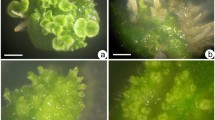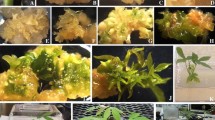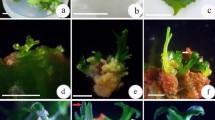Abstract
Dichanthium annulatum is a popular halophyte C4 perennial forage crop of semi-arid tropics that reproduces apomictically. In vitro plant regeneration in apomictic species helps in producing new germplasm that can supplement existing breeding program. Field-collected seeds and in vitro shoot apices were tested for response to 2,4-dichlorophenoxyacetic acid (2,4-D) and 6-benzylaminopurine (BAP) for initiation of somatic embryogenesis (SE) and direct shoot organogenesis (DSO). Explants produced callus on Murashige and Skoog (MS) medium with varying level of 2,4-D and 0.5 mgL–1 BAP. After 4th sub-culture, yellowish brown turns into white nodular callus tissue with a friable appearance, which exhibited the highest percentage of embryogenic callus induction on MS medium with 3.0 mgL–1 2,4-D and 0.5 mgL–1 BAP, was transferred to MS with BAP or kinetin and 0.125 mgL–1 2,4-D to promote somatic embryo germination into plantlet. The developmental stages of SE were identified using scanning electron microscopy and histology. Multiple shoots were observed with the combinations of BAP or kinetin with 2,4-D. The highest number of shoots (27) occurred on MS medium comprising 4.0 mgL–1 BAP and 0.125 mgL–1 2,4-D. In vitro plantlet was rooted on MS medium with 0.4% charcoal. The rooted 80% plants could be acclimatized and established in soil, as they showed healthy growth and fertility.




Similar content being viewed by others
Data Availability
All the data generated in the experiments are presented in the manuscript.
References
Abraham J, Thomas TD (2015) Plant regeneration from organogenic callus and assessment of clonal fidelity in Elephantopus scaber Linn. an ethno medicinal herb. Physiol Mol Biol Plants 21:269–277. https://doi.org/10.1007/s12298-015-0281-7
Awad MM, Ragab EA, El-Hela AA (2015) Phytochemical investigation and biological evaluation of Dichanthium annulatum (Forrsk). J Scientific and Innovative Res 4:131–137
Bhalla PL, Singh MB (2006) Molecular control of stem cell maintenance in shoot apical meristem. Plant Cell Rep 25:249–256. https://doi.org/10.1007/s00299-005-0071-8
Bhat V, Mahalakshmi C, Shashi, Saran S, Raina SN (2011) Dichanthium. In: Kole C (ed) Wild crop relatives: genomic and breeding resources–millets and grasses. Berlin, Springer, pp 89–112
Bradley DE, Bruneau AH, Qu R (2001) Effects of cultivar, explant treatment, and medium supplements on callus induction and plantlet regeneration in perennial ryegrass. Int Turfgrass Soc Res J 9:152–157
Bregitzer P, Zhang SB, Cho MJ, Lemaux PG (2002) Reduced somaclonal variation in barley is associated with culturing highly differentiated, meristematic tissues. Crop Sci 42:1303–1308. https://doi.org/10.2135/cropsci2002.1303
Choi YE, Yang DC, Park JC, Soh WY, Choi KT (1998) Regenerative ability of somatic single and multiple embryos from cotyledons of Korean ginseng on hormone-free medium. Plant Cell Rep 17:544–551. https://doi.org/10.1007/s002990050439
Colomba EL, Grunberg K, Griffa S, Ribotta A, Mroginski L, Biderbost E (2006) The effect of genotype and culture medium on somatic embryogenesis and plant regeneration from mature embryos of fourteen apomictic cultivars of buffel grass (Cenchrus ciliaris L.). Grass Forage Sci 61:2–8. https://doi.org/10.1111/j.1365-2494.2006.00499.x
D’Cruz R, Reddy PS (1971) Inheritance of apomixis in Dichanthium annulatum. Indian J Genet Plant Breed 31:451–460
Dabadghao PM, Shankarnarayan KA (1973) The grass cover of India. New Delhi, ICAR
Dalton SJ, Bettany AJE, Bhat V, Gupta MJ, Bailey K, Timms E, Morris P (2003) Genetic transformation of Dichanthium annulatum (Forssk)—an apomictic tropical forage grass. Plant Cell Rep 21:974–980. https://doi.org/10.1007/s00299-003-0600-2
Fatima I, Kanwal S, Mahmood T (2018) Evaluation of biological potential of selected species of family Poaceae from Bahawalpur. Pakistan BMC Compl and Alter Med 18:27. https://doi.org/10.1186/s12906-018-2092-1
Feher A, Pasternak TP, Dudits D (2003) Transition of somatic plant cells to an embryogenic state. Plant Cell, Tissue, Organ Cult 74:201–228. https://doi.org/10.1023/A:1024033216561
Gabbard BL, Fowler NL (2007) Wide ecological amplitude of a diversity reducing invasive grass. Biol Invasions 9:149–160
Gonzalez JM, Freiro E, Jouve N (2001) Influence of genotype and culture medium on callus formation and plant regeneration from immature embryos of Triticum turgidum Desf. Cultivars Plant Breed 120:513–517. https://doi.org/10.1046/j.1439-0523.2001.00661.x
Gupta MG, Gupta S, Bhat BV, Gupta S (1998) Plant regeneration from callus cultures initiated from nodes of a grass Dichanthium annulatum (Forssk) stapf. Acta Bot Ind 26:31–36
Hoagland M, Arnon DI (1950) The water culture metnod to grow plants without soil. California agricultural experiment station circular, Berkeley California
Hojsgaard D (2020) Apomixis technology: separating the wheat from the chaff. Genes 11:411. https://doi.org/10.3390/genes11040411
Jha P, Shashi, Rustagi A, Agnihotri PK, Kulkarni VM, Bhat V (2011) Efficient Agrobacterium-mediated transformation of Pennisetum glaucum (L.) R. Br. using shoot apices as explant source. Plant Cell Tissue, Organ Cult 107:501–512. https://doi.org/10.1007/s11240-011-0001-0
Jha P, Shashi, Kulkarni VM, Bhat V (2016) Thidiazuron-induced multiple shoot regeneration and in vivo flowering in Pennisetum glaucum (L.) R. Br Phytomorphology 66:45–50
Johansen DA (1940) Plant microtechnique. McGraw Hill, New York
Kumar R, Kumari B (2019) Common grasses of Bijnor district used by bhoxa tribals in their primary health care system. J Medicinal Plants Studies 7:05–07
Kumar J, Shukla SM, Bhat V, Gupta S, Gupta MG (2005) In vitro plant regeneration and genetic transformation of Dichanthium annulatum. DNA Cell Biol 24:670–679. https://doi.org/10.1089/dna.2005.24.670
Kumar A, Kumar A, Kumar P, Lata C, Kumar S (2018) Effect of individual and interactive alkalinity and salinity on physiological, biochemical and nutritional traits of Marvel grass. Indian J Exp Biol 56:573–581
Larkin PJ, Scowcroft WR (1981) Somaclonal variation—a novel source of variability from cell cultures for plant improvement. Theor Appl Genet 60:197–214
Liu P, Zang ZX, Yuan JG, ** ZB, Du XL, Yang ZY (2006) Callus induction and plant regeneration in eleven perennial ryegrass cultivars. Biotechnol Biotechnol Equip 20:30–37
Mann A, Kumar N, Lata C, Kumar A, Kumar A, Meena BL (2019) Functional annotation of differentially expressed genes under salt stress in Dichanthium annulatum. Plant Physiol Rep 24:104–111. https://doi.org/10.1007/s40502-019-0434-8
Mehra KL, Magoon ML (1974) Collection, conservation and exchange of gene pools of forage grasses. Indian J Genet 34:26
Murashige T, Skoog F (1962) A revised medium for rapid growth and bioassays with tobacco tissue culture. Physiol Plant 15:473–497. https://doi.org/10.1111/j.1399-3054.1962.tb08052.x
Nisar MF, Jaleel F, Waseem M, Ismail MS, Toor Y, Haider SM, Zhong JL (2014) Ethno-medicinal uses of plants from district Bahawalpur, Pakistan. Cur Res J Biol Sci 6:183–190. https://doi.org/10.19026/crjbs.6.5191
Pasternak TP, Prinsen E, Ayaydin F, Miskolczi P, Potters G, Asard H, Van Onckelen HA, Dudits D, Feher A (2002) The role of auxin, pH, and stress in the activation of embryogenic cell division in leaf protoplast-derived cells of alfalfa. Plant Physiol 129:1807–1819
Praveena M, Giri CC (2012) Plant regeneration from immature inflorescence derived callus cultures of salt tolerant kallar grass (Leptochloa fusca L.). Physiol Mol Biol Plants 18:345–356. https://doi.org/10.1007/s12298-012-0134-6
Rajyalakshmi K, Grover A, Maheshwari N, Tyagi AK, Maheshwari SC (1991) High frequency regeneration of plantlets from the leaf bases via somatic embryogenesis and comparison of polypeptide profiles from morphogenic and non-morphogenic calli in wheat (Triticum aestivum). Physiol Plant 82:617–623. https://doi.org/10.1111/j.1399-3054.1991.tb02955.x
Scowcroft WR, Larkin PJ (1988) Somaclonal variation. In: Bock G, Marsh J (eds.) Applications of plant cell and tissue culture, Ciba foundation symposium, 137, Wiley, England
Shashi, Bhat V (2021) Enhanced somatic embryogenesis and plantlet regeneration in Cenchrus ciliaris L. In Vitro Cell Dev Biol- Plant 57:499–509. https://doi.org/10.1007/s11627-020-10148-y
Shashi, Bhat V (2022) Plant regeneration via somatic embryogenesis and direct shoot organogenesis of a C4 bioenergy crop Pennisetum pedicellatum Trin. S Afr J Bot 146:286–292. https://doi.org/10.1016/j.sajb.2021.10.020
Singh P, Singh PK, Sahu S, Singh A, Gaurav N, Singh N (2017) Ecological study of grasses in Mukundpur range of Satna forest division Madhya Pradesh with the assessment of threat and conservation status. J Medicinal Plants Studies 5:07–12
Sivadas P, Chandra N, Kothari SL (1992) Histology of somatic embryogenesis and shoot bud formation in tissue cultures of the finger millet (Eleusine coracana (L.) Gaertn.). Phytomorphology 42:203–207
Soreng RJ, Peterson PM, Romaschenko K, Davidse G, Zuloaga FO, Judziewicz EJ, Filgueiras TS, Davis JI, Morrne O (2015) A worldwide phylogenetic classification of the Poaceae (Gramineae). J Syst Evol 53:117–137
Srivatanakul M, Park S, Sanders J, Salas M, Smith R (2000) Multiple shoot regeneration of kenaf (Hibicus cannabinus L.) from a shoot apex culture system. Plant Cell Rep 19:1165–1170. https://doi.org/10.1007/s002990000256
Van der Valk P, Ruis F, Tettelaar-Schrier AM, Van De Velde CM (1995) Optimizing plant regeneration from seed-derived callus culture of Kentucky bluegrass. The effect of benzyladenine. Plant Cell Tissue Organ Cult 40:101–103. https://doi.org/10.1007/BF00041125
Vasil V, Vasil IK (1982) The ontogeny of somatic embryos of Pennisetum americanum (L.) K. Schum. in cultured immature embryos. Botl Gaz 143:454–456
Vielle-Calzada JP, Crane CF, Stelly DM (1996) Apomixis: the asexual revolution. Science 274:1322–1323
Wied JP, Perotto-Baldivieso HL, Conkey AAT, Brennan LA, Mata JM (2020) Invasive grasses in South Texas rangelands: historical perspectives and future directions. Invasive Plant Sci Manag 13:41–58
Yadav CB, Jha P, Mahalakshmi C, Anjaiah V, Bhat V (2009) Somatic embryogenesis and regeneration of Cenchrus ciliaris genotypes from immature inflorescence explants. Biol Plant 53:603–609. https://doi.org/10.1007/s10535-009-0111-2
Yookongkaew N, Srivatanakul M, Narangajavana J (2007) Development of genotype independent regeneration system for transformation of rice (Oryza sativa ssp. indica). J Plant Res 120:237–245. https://doi.org/10.1007/s10265-006-0046-z
Zhang S, Zhong H, Sticklen MB (1996) Production of multiple shoots from shoot apical meristems of Oat (Avena sativa L.). J Plant Physiol 148:667–671. https://doi.org/10.1016/S0176-1617(96)80365-8
Acknowledgements
The authors acknowledge IGFRI, Jhansi for providing the seed material used in this study. A part of research work was financially supported by R and D Grant from the University of Delhi, Delhi.
Author information
Authors and Affiliations
Corresponding author
Ethics declarations
Conflict of interest
The authors declare that there is no potential conflict of interest.
Additional information
Publisher's Note
Springer Nature remains neutral with regard to jurisdictional claims in published maps and institutional affiliations.
Rights and permissions
Springer Nature or its licensor (e.g. a society or other partner) holds exclusive rights to this article under a publishing agreement with the author(s) or other rightsholder(s); author self-archiving of the accepted manuscript version of this article is solely governed by the terms of such publishing agreement and applicable law.
About this article
Cite this article
Shashi, Maity, P.J. & Bhat, V. Efficient plantlet regeneration via somatic embryogenesis and shoot organogenesis in Dichanthium annulatum (Forssk.): a halophyte C4 apomictic forage crop. Plant Biotechnol Rep 17, 615–624 (2023). https://doi.org/10.1007/s11816-023-00864-3
Received:
Revised:
Accepted:
Published:
Issue Date:
DOI: https://doi.org/10.1007/s11816-023-00864-3




